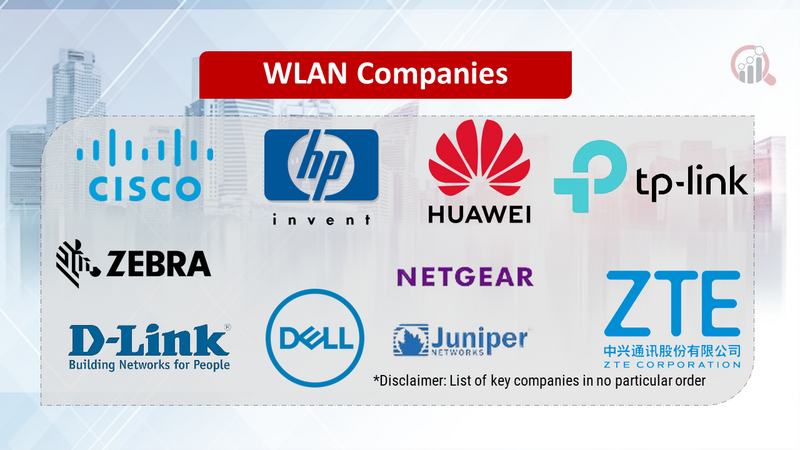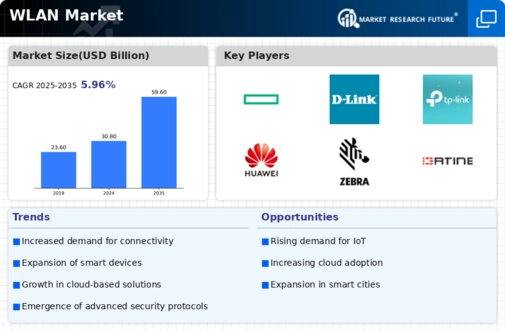Top Industry Leaders in the WLAN Market

Navigating the Waves: WLAN Market Landscape
The WLAN market, encompassing wireless local area networks, is experiencing a vibrant surge driven by the ever-increasing demand for seamless connectivity. this market presents a lucrative playing field for established players and hungry newcomers alike. Let's dive into the depths of this dynamic landscape, exploring key players, strategic approaches, and the currents shaping future dominance.
Key Players:
- Cisco (U.S.)
- Aruba Networks, Inc. (U.S.)
- HP (U.S.)
- Ruckus Wireless (U.S.)
- Ubiquiti Networks (U.S.)
- Aerohive Networks (U.S.)
- Huawei (China)
- Zebra Technologies (U.S.)
- Netgear (U.S.)
- D-Link (Taiwan)
- TP-Link (China)
- Juniper Networks (U.S.)
- Boingo Wireless ( U.S.)
- Dell Inc. ( U.S.)
- ZTE Corporation (China)
Strategies Charting the Course:
-
Technology Advancements: Embracing Wi-Fi 6 and Wi-Fi 7 standards, offering high speed, low latency, and increased device density, is crucial for staying ahead of the curve. -
Cloud-based Solutions: Offering cloud-managed access points and network management platforms provides scalability, cost-efficiency, and remote accessibility, attractive for modern businesses. -
Security and Compliance Focus: Addressing data security concerns and complying with industry regulations through advanced encryption and network segmentation builds trust and expands market reach. -
Vertical Market Focus: Developing tailored solutions for specific industries like healthcare, hospitality, or manufacturing with industry-specific features and integrations increases relevance and competitive edge.
Factors Anchoring Market Share:
-
Product Portfolio Breadth and Features: Offering a range of access points, controllers, software tools, and advanced functionalities like network analytics and guest access management attracts diverse clients. -
Technology Leadership and Innovation: Being at the forefront of Wi-Fi advancements, cloud platforms, and AI integration builds brand reputation and attracts technology-driven clients. -
Price Competitiveness and Value Proposition: Balancing feature-richness with competitive pricing and addressing specific client needs is crucial for securing market share. -
Global Reach and Regional Presence: Extensive distribution networks, localization of solutions, and understanding of regional regulations are essential for international expansion. -
Partnerships and Ecosystem Development: Collaborating with technology providers, service integrators, and industry players fosters innovation, broadens reach, and offers comprehensive solutions.
Rising Stars on the Horizon:
-
Startups Offering Specialized Solutions: Companies like Mist, Enconnex, and Plume bring niche expertise in areas like Wi-Fi optimization, cloud management, and smart home networks, targeting specific market segments. -
Open-source WLAN Hardware and Software: The rise of open-source options like OpenWRT and OpenMesh is offering affordable alternatives, potentially disrupting the traditional vendor landscape. -
Network-as-a-Service (NaaS) Providers: Companies like CloudGenix and Nomadic are offering managed WLAN services through subscription models, appealing to clients seeking operational simplicity.
Investment Trends Steering the Future:
-
R&D in Wi-Fi Technology: Continuous development in areas like Wi-Fi 6E, mmWave, and next-generation standards is crucial for maintaining technological leadership. -
Cloud Platform Expansion and AI Integration: Investing in cloud-based management tools and leveraging AI for network optimization and automation are key priorities for future growth. -
Cybersecurity and Compliance Enhancements: Strengthening data security features and ensuring regulatory compliance are essential for building trust and mitigating risks. -
Partnerships and Acquisitions: Collaborations and acquisitions in areas like IoT integration, data analytics, and network security accelerate innovation and diversify market offerings.
Sailing Towards Market Dominance:
The WLAN market offers vast opportunities for players who navigate its currents with agility and foresight. By prioritizing innovation, focusing on specific market segments, embracing cloud technologies, and ensuring robust security, companies can chart a course towards market dominance and ride the wave of wireless connectivity into the future.
Latest Company Updates:
October 24, 2023: Wi-Fi 7 Standard Finalized, Promising Gigabit Speeds and Improved Latency
- The Wi-Fi Alliance finalizes the Wi-Fi 7 standard, offering significant improvements over Wi-Fi 6, including multi-gigabit speeds, lower latency, and enhanced reliability in crowded environments. This paves the way for a new generation of high-performance wireless devices.
December 12, 2023: FCC Approves 6 GHz Band for Unlicensed Wi-Fi Use, Opening Up New Spectrum for Faster Speeds
- The Federal Communications Commission (FCC) approves the use of the 6 GHz band for unlicensed Wi-Fi, significantly expanding the available spectrum for WLANs. This additional spectrum promises faster speeds and reduced congestion, particularly in densely populated areas.
January 10, 2024: Juniper Networks Introduces New WLAN Access Points Optimized for High-Density Environments
- Juniper Networks unveils a new line of WLAN access points designed for high-density environments, such as stadiums, airports, and convention centers. These access points offer enhanced scalability, security, and performance for handling large numbers of connected devices.









